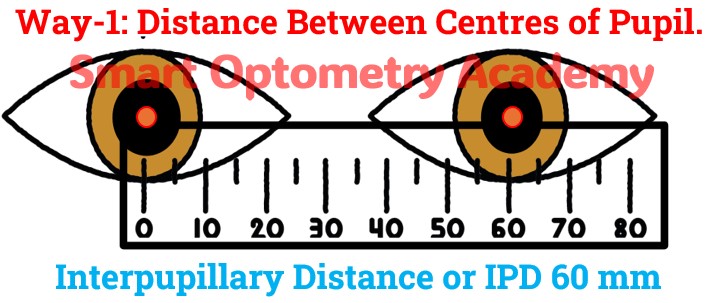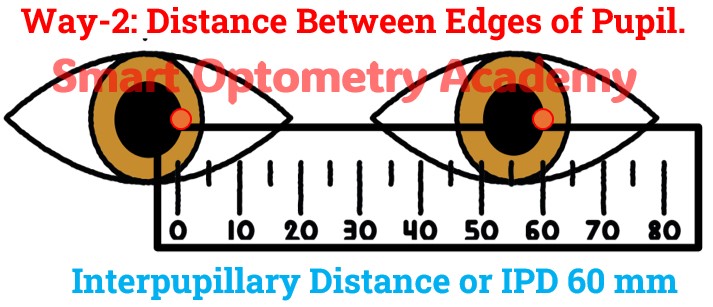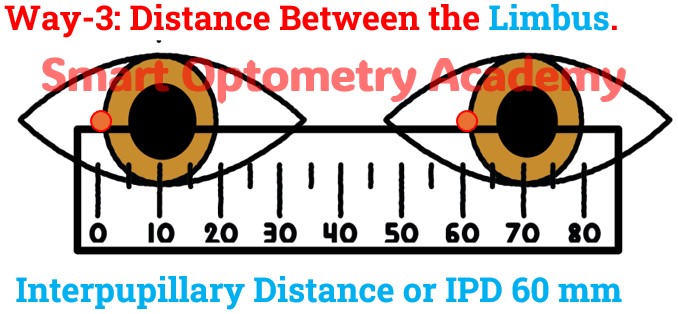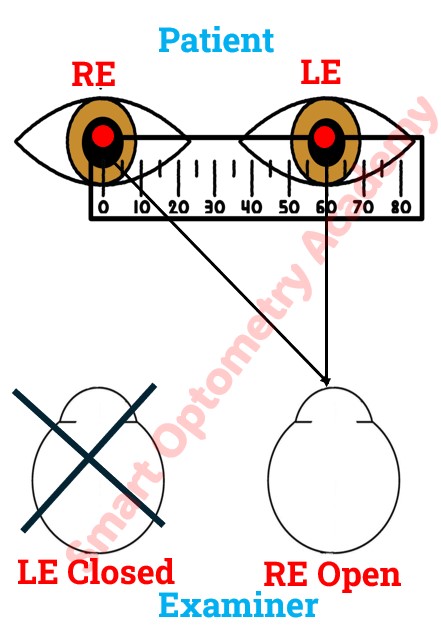Table of Contents
What is Interpupillary Distance (IPD)?

- Interpupillary Distance (IPD) refers to the distance between the centers of the pupils of the eyes, typically measured in millimeters.
- This measurement is essential for ensuring that prescription glasses are accurately made and positioned for optimal vision correction.
- Whether before conducting a visual examination or ordering glasses, knowing the precise interpupillary distance is a fundamental step in eye care.
Types of Interpupillary Distance (IPD)
- There are three main types of Interpupillary Distance (IPD) based on different visual tasks:
1. Distance Interpupillary Distance (IPD):
- This measurement is taken when the eyes are focused on distant objects. It is the most common type of IPD used when creating glasses for distance vision.
2. Near Interpupillary Distance (IPD):
- This refers to the measurement of IPD when the eyes are focusing on near objects, such as when reading or doing close-up work. Since the eyes converge when looking at nearby objects, the near IPD is typically smaller than the distance IPD.
3. Monocular Pupillary Distance (IPD):
- Unlike the standard IPD, which measures the distance between both pupils, monocular IPD measures the distance from the center of each pupil to the center of the nose.
- This measurement is especially important for asymmetrical faces or when fitting progressive lenses.
.
.
Methods to Measure Interpupillary Distance (IPD)
- Several techniques can be used to measure IPD, including:
1. Distance Between the Centers of Pupils:

- This is the most accurate and commonly used method for measuring IPD.
- It is the distance between the center of pupil of one eye to center of pupil of another eye.
2. Distance Between the Edges of Pupils:

- It is the distance between the inner/outer edge of pupil of one eye to outer/inner edge of pupil of another eye.
- Inner edge of right eye to outer edge of left eye or outer edge of right eye to inner edge of left eye.
3. Distance Between the Limbal Edges:

- It is the distance between the inner/outer limbus of one eye to outer/inner limbus of another eye.
- Inner limbus of right eye to outer limbus of left eye or outer limbus of right eye to inner limbus of left eye.
4. Distance Between the Exo-canthus and Endo-canthus:

- It is the distance between the inner/outer Canthus of one eye to outer/inner Canthus of another eye.
- Inner Canthus of right eye to outer Canthus of left eye or outer Canthus of right eye to inner Canthus of left eye.
.
.
Instruments Used to Measure IPD
- Several tools can be employed to measure interpupillary distance:

1. Normal Millimeter Scale:
- A basic and straightforward tool for measuring IPD, though accuracy may depend on the skill of the person taking the measurement.
2. Pupillometers:
- These are specialized devices that offer a highly accurate measurement of IPD. Commonly used pupillometers include:
- Essilor Pupillometer
- Topcon-5
- PD Meter
How to Measure Distance Binocular Interpupillary Distance (IPD)
- Distance Binocular Interpupillary Distance (IPD) involves determining the distance between the centers of both pupils, measured in millimeters, when the patient is focusing on a distant object.
- Here’s a step-by-step guide to measuring Interpupillary Distance (IPD) using a millimeter scale.
Requirements of Distance Binocular Interpupillary Distance (IPD):
- Millimeter Scale: A standard mm scale for measuring.
- Patient: The individual whose IPD is being measured.
- Examiner: The person responsible for taking the measurements.
Patient Preparation of Distance Binocular Interpupillary Distance (IPD):
- Fixation Instructions:
- Ask the patient to focus as directed by the examiner, typically on the examiner’s eye.
- Head Stability:
- Instruct the patient to keep their head still throughout the procedure to ensure an accurate measurement.
Examiner Preparation of Distance Binocular Interpupillary Distance (IPD):
- Eye Level Alignment:
- Ensure that both the examiner and the patient are at the same height, so their eyes are level.
- Positioning:
- The examiner’s right eye should be in front of the patient’s left eye, and vice versa.
Steps to Measure Distance Binocular Interpupillary Distance (IPD):

- Positioning:
- The examiner should sit about 40 cm (16 inches) from the patient, ensuring their eyes are at the same level.
- Initial Fixation:
- The examiner closes their right eye and instructs the patient to focus on the examiner’s left eye.
- Marking Centre of Right Eye:
- Hold the millimeter scale in front of the patient’s eyes and align the zero point of the scale with the center of the patient’s right pupil, left pupillary border, or left limbus.
- Switching Focus:
- The examiner then closes their left eye and asks the patient to focus on the examiner’s right eye.
.
.
.

- Marking Centre of Left Eye:
- The examiner mark the center of Left eye and reads the measurement where the scale aligns with the center of the patient’s left pupil, left pupillary border, or left limbus.
- Rechecking Accuracy:
- To ensure accuracy, the examiner repeats the process by closing their right eye again and instructing the patient to focus on the left eye.
- The zero point should still align with the right pupil or other reference points as initially measured.
- Confirm Measurement:
- After confirming that the zero point is still correctly aligned, the examiner can finalize the Interpupillary Distance (IPD) measurement.
How to Measure Near Interpupillary Distance (IPD)
This procedure calculates the distance between the centers of the pupils when the patient is focusing on a near object, ensuring proper lens centration for activities that require closer focus.
Requirements of Near Interpupillary Distance (IPD):
- Millimeter Scale: A precise mm scale for measurement.
- Patient: The person whose Near Interpupillary Distance (IPD) is being measured.
- Examiner: The individual performing the measurement.
Patient Preparation of Near Interpupillary Distance (IPD):
- Fixation Instruction:
- Instruct the patient to keep their head still and focus on the examiner’s right eye during the procedure.
- Head Stability:
- Ensure the patient maintains a steady head position throughout to avoid measurement errors.
Examiner Preparation of Near Interpupillary Distance (IPD):
- Eye Level Alignment:
- Ensure that the eyes of the examiner and the patient are at the same height.
- Positioning:
- The examiner’s right eye should be positioned directly in front of the patient’s nose.
.
.
Procedure to Measure Near Interpupillary Distance (IPD):
- Positioning:
- The examiner sits at a distance of 40 cm (16 inches) from the patient, ensuring both are at the same eye level.
- Alignment for Near Vision:
- The examiner brings their right eye directly in front of the patient’s nose, at the patient’s typical near working distance, which is usually around 40 cm.
- Fixation and Eye Closure:
- The examiner closes their left eye, instructing the patient to fixate on the examiner’s right eye.
- Zero Point Alignment:
- The examiner places the zero point of the millimeter scale at the center of the patient’s right pupil.
- Reading the Scale:
- After aligning the scale’s zero point, the examiner reads the measurement where the scale lines up with the center of the patient’s left pupil. This value is the Near Interpupillary Distance (IPD).
How to Measure Monocular Interpupillary Distance (IPD):
Measuring Monocular Interpupillary Distance (IPD) is essential for accurately positioning the optical centers of the lenses directly in front of each eye, especially since many individuals have asymmetric facial structures.
Requirements of Monocular Interpupillary Distance (IPD):
- Millimeter Scale: A standard mm scale for measuring.
- Patient: The individual whose Monocular Interpupillary Distance (IPD) is being measured.
- Examiner: The person conducting the measurement.
Patient Preparation of Monocular Interpupillary Distance (IPD):
- Fixation Instruction:
- The patient should be instructed to keep their head still throughout the process and to fixate on the examiner’s right eye when asked.
- Head Stability:
- Ensure that the patient maintains a steady head position to ensure an accurate measurement.
Examiner Preparation of Monocular Interpupillary Distance (IPD):
- Eye Level Alignment:
- The examiner and the patient should be at the same height, with the examiner’s right eye positioned in front of the patient’s left eye and vice versa.
.
.
Procedure to Measure Monocular Interpupillary Distance (IPD):
- Positioning:
- The examiner sits at a distance of 40 cm (16 inches) from the patient, maintaining the same eye level.
- Initial Fixation:
- The examiner closes their right eye, and the patient is instructed to fixate on the examiner’s left eye.
- Aligning the Millimeter Scale:
- The examiner holds the millimeter scale in front of the patient’s eyes and aligns the zero point of the scale with the center of the patient’s right pupil.
- Switching Eyes for Measurement:
- The examiner now closes their left eye, and the patient is instructed to fixate on the examiner’s right eye.
- Recording the Binocular PD:
- The examiner reads the scale in line with the center of the patient’s left pupil. This is the Binocular PD (the total distance between the centers of both pupils).
- Noting Monocular PD for the Right Eye:
- Without moving the ruler, the examiner notes the scale reading at the center of the patient’s nose. This is the Monocular PD for the right eye.
- Calculating Monocular PD for the Left Eye:
- To calculate the Monocular PD for the left eye, subtract the right monocular PD reading (from step 6) from the binocular PD. The difference gives the left monocular PD.
.
.
Example Calculation:
- If the Binocular PD is 66 mm and the scale reading at the center of the nose is 32 mm, the Monocular PD for the right eye is 32 mm.
- To calculate the Monocular PD for the left eye:
- 66 – 32 = 34 mm
- Thus, the Monocular PD for the left eye is 34 mm.
- Check Our Courses: Ophthalmic Instrumentation, Clinical Refraction, Contact Lens, Binocular Vision, Dispensing Optics, MCQs in Optometry
- Download our App “Optometry Notes & MCQs” from Google Play Store.




